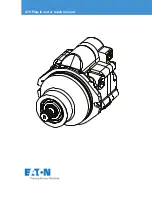
6.1
ADJUSTMENT PROCEDURE CHART
TABLE II
ADJUTMENT
N
AME
DESCRIPTION OF FUNCTION: NOTES
ADJUSTEMENT PROCEDURE:
A
pp
oximate method:
"IR"
a)
Set speed control knob for 20% speed.
b)
Rotate "IR" trim pot clockwise until motor begins to hunt.
If load slow down is of no concern, rotate
"IR" trim pot fully counterclockwise.
c)
Back off "IR" trim pot 1/3rd of the span between this setting and zero setting.
This method usually results in slight over compensation.
Exact method:
a)
Turn drive power off and connect a DC ammeter in series with the A1 motor lead
between motor and control.
Do not
use clam
p-on meter.
b)
Set speed control knob for 20% speed.
c)
Load the motor shaft until ammeter reads rated motor current [see nameplate].
Read motor s
peed with strobe li
ght or tachometer.
e)
If motor speed decreased as motor was loaded, adjust the "IR" trim pot and
re
peat
( c
) and
( d
) until little or no s
peed decrease is noted.
f)
In performing ( d ) and ( e ), be sure motor is not loaded heavily enough to cause
tor
que limitin
g to occur.
g)
Remove ammeter and reconnect A1 motor lead. Recheck control at very low
sp
eed for co
gg
in
g.
"MIN"
a)
Set the speed control knob to zero.
b)
Rotate the "MIN" trim pot clockwise until motor starts to rotate.
Clockwise rotation of "MIN" trim pot
increases s
peed.
c)
Decrease the "MIN" trim pot setting until rotation stops.
Sets the load regulation (% slowdown of
motor as shaft load is changed from zero to
[In tach feedback systems this pot must be
turned fully counterclockwise.]
Sets the zero calibration of the speed
control knob.











































